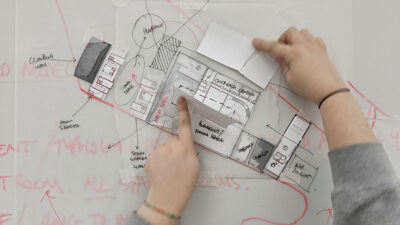Commencing your journey in architecture school can prove to be an entirely distinct experience from any you’ve encountered thus far. The knowledge imparted within the walls of architecture institutions primarily revolves around the intricacies of architectural practice, which means you’re unlikely to have been exposed to much of this content unless you’ve previously delved into architectural studies or literature. Fret not, for you’ll find solace in the fact that most of your fellow students are navigating this uncharted territory alongside you.
As you embark on your architectural education, you’ll quickly realize that the learning process diverges significantly from the conventional educational path. There will be a series of adjustments to make, chiefly in terms of your study methods and learning strategies, as well as the array of classes you’ll be attending.
Exploring the Realm of Self-Directed Learning in Architecture School
Embarking on your academic journey at an architecture school or any higher education institution marks a significant transition. The fundamental shift lies in the realm of independent adult learning. Unlike your earlier school years, where your attendance was mandatory and someone was always there to ensure you were in class, the world of college or university puts you in the driver’s seat. You’ve chosen to be here, and no one will be chasing you down if you miss a lecture or skip a study session.
What Sets Independent Learning Apart:
- Personal Choice: You’ve chosen to immerse yourself in the fascinating world of architecture. This decision signifies a pivotal moment where you take control of your education and steer your own learning journey;
- No Hand-Holding: Unlike school, where teachers closely monitored attendance, you’re now in a bustling environment with hundreds of students. Professors might send a reminder email during your initial weeks, but they won’t be following you to class;
- The Power of Responsibility: Independent learning requires you to shoulder the responsibility for your academic progress. It’s all about embracing the freedom to chart your course, but it comes with the requirement to be accountable for your choices.
Navigating the Landscape of Self-Directed Learning:
- Get Organized: The first step is to create a structured framework for your studies. This involves setting up a study schedule, organizing your study materials, and creating a conducive learning environment;
- Attendance Matters: Attend classes regularly. While no one may force you to attend, your presence can significantly enhance your understanding of complex architectural concepts and foster meaningful connections with professors and peers;
- Consistency is Key: Consistency is the cornerstone of successful independent learning. Establish a routine that accommodates both your coursework and personal life, ensuring a balanced approach to your education;
- Habit Formation: Develop good study habits early on. This includes effective note-taking, time management, and seeking help when needed;
- Planning and Prioritization: Break down your coursework into manageable tasks. Create a study plan with deadlines, ensuring you stay on track and complete assignments on time;
- Seek Guidance: Don’t hesitate to reach out to your professors or academic advisors for guidance and support. They are valuable resources on your academic journey;
- Leverage Technology: Explore educational apps and tools that can aid your learning process. There are numerous resources available for architectural design, modeling, and research;
- Peer Collaboration: Collaborate with fellow students. Group study sessions and peer discussions can provide different perspectives and enhance your understanding of architectural principles;
- Self-Assessment: Regularly evaluate your progress and adjust your strategies as needed. Self-reflection is a powerful tool for improvement;
- Stay Informed: Keep up with industry trends and architectural innovations. Engaging with the ever-evolving field of architecture can inspire your coursework and projects.
Understanding the Workload in Architecture and Design Schools
- Significant Workload: In architecture and design education, students encounter a substantial workload, often surpassing that of peers in fields like business or science;
- Comparison with Other Disciplines: Unlike some other disciplines where students might engage in last-minute cramming or quickly compose essays, architecture and design demand more consistent and thorough effort.
Key Characteristics of the Workload in Architecture and Design
- Consistency and Rigor: Success in these fields hinges on continuous and meticulous work. Simply meeting the minimum requirements is often insufficient for excelling;
- Extended Hours and Commitment: Students frequently find themselves dedicating time beyond the classroom, including nights, weekends, and even during breaks. This is essential for completing projects and mastering new skills or software.
Recommendations and Tips for Managing the Workload
- Time Management Skills: Develop effective time management strategies to balance academic and personal life;
- Prioritize Tasks: Learn to prioritize tasks and set realistic deadlines for each project phase;
- Continuous Learning: Embrace the need for ongoing learning, including self-teaching new software and techniques;
- Peer Support and Collaboration: Engage with fellow students for support and collaborative learning experiences;
- Self-Care: Remember to take breaks and maintain a healthy lifestyle to ensure peak mental and physical health.
Insights into the Architectural Learning Process
- Hands-On Experience: Building models and creating detailed drawings are integral parts of the learning process, offering practical experience;
- Adapting to Intensive Work Cycles: Students should be prepared for intense periods of work, especially leading up to project deadlines or presentations;
- Leveraging Resources: Utilize available resources, including software tutorials, workshops, and faculty guidance to enhance learning and efficiency.
Diverse Student Landscape at Architecture School
Embarking on your journey at an architecture school is akin to stepping into a vibrant, multifaceted world. You’ll be surrounded by a mosaic of students, each with their unique backgrounds, experiences, and skills. This diversity enriches the educational tapestry, providing you with opportunities for unparalleled growth and collaboration.
Key insights and recommendations:
- Embrace Diversity: Embrace the variety of perspectives and skills your fellow students bring to the table. Learning from others with different strengths can broaden your own horizons;
- Network Actively: Forge connections with students from various backgrounds. These relationships can be instrumental in your academic and professional journey;
- Collaborate: Seek out opportunities for collaboration on projects. Combining your strengths with those of others can result in innovative and remarkable designs.
Navigating the First Year
Entering your first year of architecture school can be an exhilarating yet daunting experience. Within your cohort, you’ll discover individuals excelling in various aspects of architecture, such as drawing, design, graphics, software proficiency, and documentation. Some students will exhibit unwavering dedication, while others may struggle to find their footing. It’s a year of exploration, self-discovery, and laying the foundation for your architectural career.
Valuable insights and tips:
- Experiment Widely: Use your first year as a testing ground to experiment with different aspects of architecture. Explore drawing, design, and software to discover your innate talents and interests;
- Time Management: Developing effective time management skills is crucial. Balancing coursework, projects, and personal life will help you thrive academically and maintain your enthusiasm for architecture;
- Peer Support: Establish a support network with your peers. Share your challenges and triumphs; you’re likely to find common ground and solutions together.
Thriving in a Competitive Environment
Architecture and design fields are inherently competitive. Students often find themselves constantly comparing their skills, knowledge, ideas, and grades with their peers. In these early years, it’s vital to recognize that everyone possesses unique strengths that can evolve over time. The field of architecture offers a vast spectrum of opportunities catering to diverse talents.
Actionable insights and strategies:
- Identify Your Strengths: Reflect on your skills and interests. Are you more inclined towards conceptual design, technical proficiency, project management, or something else? Identify your niche within architecture;
- Continuous Learning: Take responsibility for your learning journey. Seek out courses, workshops, and resources that align with your interests and goals;
- Collaborative Synergy: Consider forming collaborations with peers who complement your skills. This synergistic approach can lead to holistic and innovative architectural solutions.
Diverse Learning Styles in Architecture School
In the realm of architectural education, one encounters a captivating blend of diverse learning styles that set it apart from conventional academic disciplines. While many fields lean heavily on traditional modes of study such as lectures, assignments, essays, and exams, architecture stands apart as a unique and multifaceted discipline. As an aspiring architect, you’ll need to brace yourself for a dynamic journey that demands creativity, critical thinking, analytical prowess, and a zest for experimentation.
- Creativity Unleashed: Unlike many other academic pursuits, architecture places a premium on creativity. Expect to delve into the realms of imagination and innovation as you explore, design, and shape the built environment. Embrace the opportunity to translate your imaginative concepts into tangible structures and spaces;
- Critical Thinking and Problem Solving: Architecture isn’t merely about aesthetics; it’s about solving complex problems in the realm of design. Your education will nurture your ability to dissect challenges, think critically, and devise innovative solutions. The architectural process is a symphony of creativity and problem-solving, harmoniously intertwined;
- The Art of Experimentation: In architecture, experimentation is your compass. You’ll be encouraged to venture into uncharted territories, test novel ideas, and push the boundaries of conventional design. This aspect of learning fosters resilience, adaptability, and an appetite for exploring uncharted territory;
- Studio Culture: One of the distinctive features of architecture school is the vibrant studio culture. Here, you won’t be confined to solitary study; instead, you’ll engage with fellow students in collaborative endeavors. Studios become incubators of ideas, where you collectively research, analyze, and explore concepts. It’s an environment that fuels creativity and fosters peer learning.
Enhancing Your Architectural Education
Now that you’re acquainted with the unique learning styles in architecture school, let’s explore ways to maximize your educational experience:
- Form Study Groups: Forming study groups is a potent strategy to deepen your understanding of architectural concepts. Collaborating with peers allows you to tackle complex problems collectively, gain fresh perspectives, and refine your ideas;
- Embrace Multidisciplinary Learning: Architecture transcends boundaries; it’s an interdisciplinary field that draws from art, engineering, sociology, and more. Embrace this diversity, as it enriches your understanding and empowers you to create holistic, meaningful designs;
- Document Your Journey: In architecture, the process is as crucial as the final outcome. Keep a visual diary or sketchbook to document your creative journey. This not only aids in self-reflection but also serves as a valuable portfolio of your evolving skills;
- Seek Mentorship: Don’t hesitate to seek guidance from professors and experienced architects. Mentorship can provide invaluable insights, career advice, and a deeper understanding of the profession.
Exploring the Diversity of Architecture School Classes
Architecture school offers a captivating array of classes that will take you on a journey through the multifaceted world of design, history, communication, and construction. These courses are designed to equip aspiring architects with a well-rounded skill set and a deep understanding of the field. As you embark on this educational adventure, you’ll find yourself immersed in a rich tapestry of knowledge and creativity. Also, explore the magic of design briefs in architecture, turning dreams into stunning structures. Get inspired today!

Design Studios: Crafting Architectural Masterpieces
Design studios are the heart and soul of architecture school. In these immersive workshops, you’ll transform your creative visions into tangible architectural designs. Here’s what you can expect:
- Collaborative Environment: Work closely with professors and fellow students, fostering a culture of creativity, critique, and collaboration;
- Hands-On Experience: Utilize state-of-the-art tools, software, and materials to bring your architectural concepts to life;
- Real-World Projects: Dive into real-world design challenges, from designing sustainable homes to envisioning futuristic urban landscapes;
- Portfolio Building: Each project is an opportunity to build an impressive portfolio, showcasing your evolving skills and style;
- Tip: Embrace the design process – it’s not just about the final product, but the journey of ideation, iteration, and refinement.
History and Theory Classes: Unveiling the Architectural Narratives
Delve into the past and unravel the intricate narratives of architecture through history and theory classes. These courses provide a profound understanding of architectural evolution and thought:
- Architectural Movements: Explore the evolution of architectural styles, from classical to contemporary, and the cultural, social, and technological forces that shaped them;
- Critical Analysis: Develop a critical eye for architectural critique, examining famous buildings, their symbolism, and their impact on society;
- Theories of Space: Delve into the philosophical and theoretical aspects of spatial design, understanding how spaces influence human behavior and experiences;
- Tip: History and theory classes are your bridge to the past, offering insights that can inspire your future designs.
Communication Classes: The Art of Conveying Ideas
Effective communication is essential in the architectural world. Communication classes equip you with the skills to present your ideas convincingly, both visually and verbally:
- Visual Representation: Master architectural drawing, rendering, and modeling techniques to communicate your designs with precision;
- Presentation Skills: Hone your ability to articulate your design concepts to clients, colleagues, and the public;
- Digital Tools: Familiarize yourself with design software and 3D modeling, enhancing your ability to convey complex ideas;
- Tip: Communication is not just about what you say but how you say it – make your presentations engaging and persuasive.
Construction Classes: Building the Foundation
Understanding the nuts and bolts of construction is fundamental for architects. Construction classes provide you with the knowledge to turn your designs into reality:
- Building Materials: Learn about different materials, their properties, and how to choose the right ones for your projects;
- Structural Systems: Explore the principles of load-bearing structures, ensuring the safety and integrity of your designs;
- Sustainable Practices: Embrace eco-friendly construction methods and technologies to create environmentally responsible architecture;
- Tip: By grasping construction principles, you’ll design with practicality, durability, and sustainability in mind.
Conclusion
Attending architecture school demands significant effort, whether you aspire to excel or merely pass. Much like other design disciplines, it doesn’t offer an effortless journey; however, if it aligns with your passion, it can yield immense satisfaction and open doors to diverse career prospects and captivating areas of exploration.
In essence, architecture ought to be regarded as a lifelong pursuit, with architecture school serving as your initial stepping stone in this journey. The path to becoming a proficient architect entails a wealth of knowledge acquisition, and every piece of information absorbed holds significance in your future practice. Your level of commitment, your genuine passion for the field, and your specific areas of architectural interest all play pivotal roles in shaping your trajectory. Thus, it’s crucial to view architecture school as a pivotal beginning rather than the ultimate destination.











